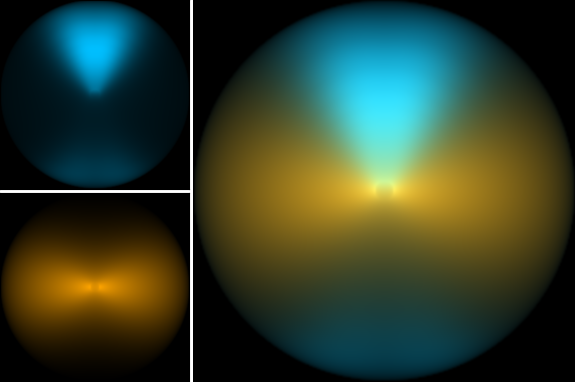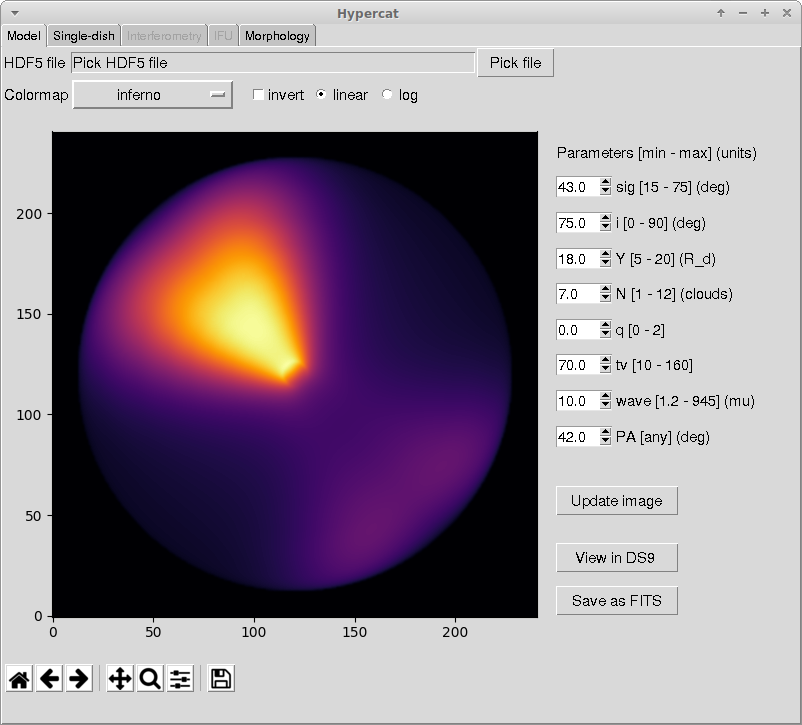Images
CLUMPY brightness & dust maps, and HYPERCAT software package
We have released large hypercubes of CLUMPY brightness and dust maps (anonymous FTP), together with the HYPERCAT Python software suite (on GitHub) for easy handling of the data. HYPERCAT stands for "Hypercubes of clumpy AGN Tori".
The accompanying papers have been published in ApJ:
Nikutta, Lopez-Rodriguez, Ichikawa, Levenson, Packham, Hönig, Alonso-Herrero
- "Hypercubes of AGN Tori (HYPERCAT) -- I. Models and Image Morphology", ApJ 2021, 919, 136
- "Hypercubes of AGN Tori (HYPERCAT) -- II. Resolving the Torus with Extremely Large Telescopes", ApJ 2021 (accepted)
The main goal of the HYPERCAT software is to make it easy to obtain brightness maps and 2D projected dust maps of torus models generated by CLUMPY (or other codes).

CLUMPY brightness map of thermal dust emission from a particular model at 9.5 micron (blue, upper-left) and 860 micron (gold, lower-left), and their composite in the large panel.
The images are computed very quickly via N-dimensional interpolation on a 9-dimensional pre-computed grid (called imgdata) with parameter axes: \(\sigma, i, Y, N_0, q, \tau_V\), wave, and the x and y (pixel) axes. The dust maps do not depend on wave and \(\tau_V\), and depend on \(N_0\) only as a multiplicative factor, thus the hypercube of dust maps (called clddata) only has 6 axes. All images and maps can be rotated to any desired position angle.
Simulating observations
Further, provides HYPERCAT functions to compute the PSFs of telescopes, and to apply these PSF to the CLUMPY images to simulate observations, together with detector pixelization and noise addition. HYPERCAT comes bundled with the pupil images of several telescopes, including the upcoming generation of extremely large telescopes, for immediate use, i.e. JWST, Keck, GMT, TMT, ELT.

Pupil images of several telescopes available with HYPERCAT
Other observation modes are or can also be supported, namely interferometry and IFU-like observations (spectrally resolved per-pixel observations).
Study the morphologies of emission and dust distributions
HYPERCAT comes with a built-in module for morphology studies which allows, among other things, to compute various image moments, image orientation/PA, image sizes in both directions, elongations, and more.
Use HYPERCAT via Python, GUI, web app
The HYPERCAT code can be used in several ways:
- As a Python module in your own analysis (use in scripts or Jupyter notebooks [ import hypercat as hc ]
- As a GUI (currently supports the interpolation of images) [ hypercatgui ]
- [In preparation]: As a web app (can run in your local browser) for image interpolation

The HYPERCAT GUI showing the model image corresponding to the selected parameters.
HYPERCATGUI can send the currently displayed model image to SAO DS9 if it is installed on your machine, and also save it to a FITS file.
Documentation
A User Manual and several example Jupyter notebooks provide you with enough start-up assistance to make using HYPERCAT very easy. We will also release a full API documentation and a Technical Manual (both still in preparation).